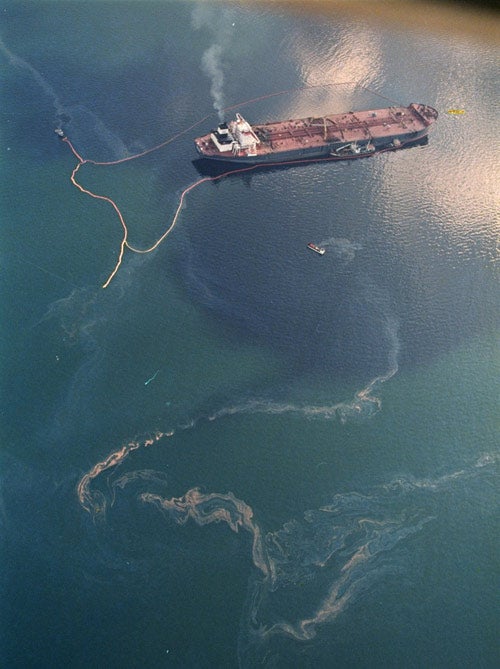Exxon could face payout 20 years after oil spill

Just after midnight, almost 20 years ago, an unqualified crewman was at the helm of the Exxon Valdez super-tanker when it ran on to a reef sending 11 million gallons of crude oil spilling into the Prince William Sound.
Yesterday, the United States Supreme Court began hearing arguments that the oil company should not have to pay $2.5bn (£1.3bn) in punitive damages to 33,000 Native Alaskans, herring and salmon fishermen, cannery workers and others. Over the years the damages have been cut in half and at least 6,000 victims of the spill owed compensation are already dead.
So far it is only the lawyers, who have charged $781m in fees, who have emerged as winners in the case. Whether those in Alaska still holding out for compensation for the ill health, wrecked lives and years of unemployment ever get any, hangs on further tortuous argument over an obscure 1818 bit of maritime law.
The case of the The Amiable Nancy saw the court rule that a ship's owner was not responsible for criminal behaviour by its crew miles out at sea. The court must now decide whether ExxonMobil should take responsibility for Joseph Hazelwood, the ship's captain who according to witnesses downed five double vodkas in waterfront bars before casting off on 23 March 1989.
After a tortuous journey though the legal system, ExxonMobil's appeal, on the ground that it has already paid out enough, $3.4bn in fines and cleanup costs, is being heard.
But in Alaska there is growing anger that a case, which became a cause célèbre of the environmental movement, has been whittled away by deliberate delaying tactics by the oil company and its allies.
"After 19 years, nobody is counting on the money," said Jennifer Gibbins, who runs an environmental group called the Prince William Soundkeeper. "This is about justice."
The images of oil-slicked seabirds, bloated whale carcasses and crude oil being hosed off once-pristine beaches were deeply shocking. But there were also assurances that a clean up would help restore a natural balance and that those inconvenienced would be well compensated.
Environmental damage from the disaster remains profound. Although Exxon's public relations department claimed the region had quickly bounced back, scientists proved that oil was still working its way through the ecosystem 19 years later. They published evidence that the oil not only killed adult herring but wiped out their eggs and larvae as well, devastating Prince William's famed herring fishery.
Fishermen who used to scoop up millions of tons of fish went empty handed. Throughout the food chain, countless species from whales to salmon had lost a vital food source.
Exxon still refuses to accept responsibility for allowing a captain it knew to be a lapsed alcoholic to take control of the ship in such dangerous and environmentally sensitive waters. Aside from the disputed punitive damages, the oil company has paid out $287m in compensatory damages, mostly in cleanup costs.
What is not disputed is that the Exxon Valdez sailed on the evening of 23 March 1989 with 53 million gallons of crude oil. To avoid icebergs, it strayed out of the shipping lane. Capt Hazelwood ordered the inexperienced third mate to turn back into the lane at a prearranged point, but then left the bridge of the ship, violating regulations. Shortly after midnight, the 1,000ft tanker ran aground on the well-marked Bligh Reef. The oil spread more than 600 miles from Bligh Reef, to the village of Chignik on the Alaska Peninsula. There would be 1,300 miles of oiled shoreline. "Spilling the oil was an accident, but putting a relapsed alcoholic in charge of a supertanker was not," the appeals court ruled in upholding the punitive damages.
At the heart of the lawsuit is the disputed accusation that Exxon ignored warnings that Mr Hazelwood was a drunk. Jeffrey L Fisher, a professor of law at Stanford University who is arguing the case for the victims, has sent the court a video of Exxon executives acknowledging fault as well as a tape of the distress call made by a clearly drunk Mr Hazelwood saying his ship was aground.
Exxon's lawyer argued that Capt Hazelwood was acquitted by a local jury of being in charge of a vessel while under the influence. Whatever crimes Capt Hazelwood committed, they were not Exxon's crimes, the lawyers contend.
A disaster by numbers
* The Exxon Valdez spilt 10.8 million gallons of crude oil into Prince William Sound.
* 1,300 miles of coastline were contaminated, with 200 miles deemed to be "heavily polluted".
* The oil spill killed 250,000 seabirds.
*300 harbour seals were killed.
* 250 bald eagles were also victims.
* 22 killer whales died.
* Despite an extensive clean-up, a study in 2007 by the US National Oceanic and Atmospheric Administration found that more than 26,000 gallons of oil remained in the sandy soil of the shoreline.
* 33,000 commercial fisherman, Native Alaskans, landowners, businesses and local governments claim they have been affected.
Subscribe to Independent Premium to bookmark this article
Want to bookmark your favourite articles and stories to read or reference later? Start your Independent Premium subscription today.

Join our commenting forum
Join thought-provoking conversations, follow other Independent readers and see their replies